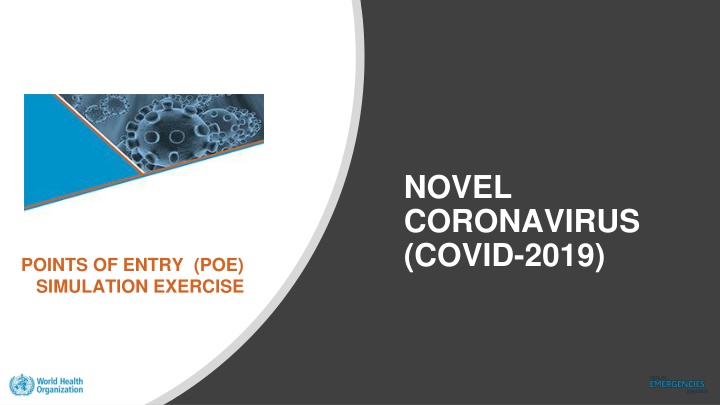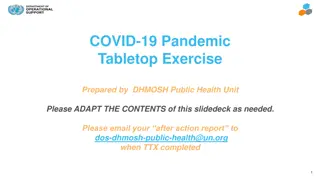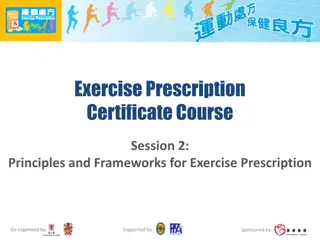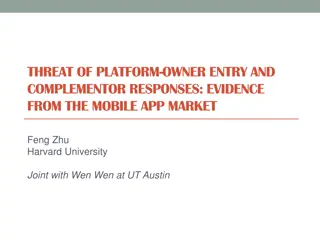COVID-19 Points of Entry (POE) Simulation Exercise Overview
The COVID-19 Points of Entry (POE) Simulation Exercise involves a Table-Top Exercise (TTX) that simulates a health emergency scenario to evaluate the preparedness of national stakeholders at main airports. The exercise aims to strengthen existing plans, procedures, and response capabilities for managing imported cases of COVID-19. Through group discussions and gap analyses based on the COVID-19 Strategic Preparedness and Response Plan (SPRP), participants will identify areas of improvement, develop action plans, and enhance readiness to respond effectively to COVID-2019 cases.
Download Presentation

Please find below an Image/Link to download the presentation.
The content on the website is provided AS IS for your information and personal use only. It may not be sold, licensed, or shared on other websites without obtaining consent from the author.If you encounter any issues during the download, it is possible that the publisher has removed the file from their server.
You are allowed to download the files provided on this website for personal or commercial use, subject to the condition that they are used lawfully. All files are the property of their respective owners.
The content on the website is provided AS IS for your information and personal use only. It may not be sold, licensed, or shared on other websites without obtaining consent from the author.
E N D
Presentation Transcript
NOVEL CORONAVIRUS (COVID-2019) POINTS OF ENTRY (POE) SIMULATION EXERCISE
Agenda Part 1: Part 2: 09:00 Re-cap 09:15 Gaps analysis & action planning (group work) 10:30 Coffee break (15 min) 10:45 Action planning continued (group work) 11:30 Consolidation in plenary session 12:00 Wrap up and next steps 12:30 Closing 08:45 Registration Introduction Exercise Objectives and how to play Table-top Simulation Coffee break (15 min) Table-top Simulation Hot-wash Close part 1 Lunch 09:00 09:10 09:15 10:45 11:00 12:30 13:00 13:00
What is a Table-Top Exercise (TTX)? A tabletop exercise (TTX) is an exercise that uses a progressive simulated scenario, together with series of scripted injects, to make participants consider the impact of a potential health emergency on existing plans, procedures and capacities. A TTX simulates an emergency situation in an informal, stress-free environment. -WHO Exercise Manual, 2017
Design & Purpose Exercise Design Based on the COVID-19 Strategic Preparedness and Response Plan (SPRP) and designed for national level operational stakeholders, involved in public health emergency preparedness or response. Purpose Through facilitated group discussion, the exercise aims to examine and strengthen your existing plans, procedures and capabilities at the main airport (POE), to manage an imported case of COVID-2019.
General objectives of the TTX General Objectives 1.Share information on the progress of your preparation, including response capabilities, plans and procedures to identify and respond to an imported case of COVID-2019 in your country. 2.Identify areas of interdependence between health actors and other sectors 3.Conduct gap analysis based on the COVID-19 Strategic Preparedness and Response Plan (SPRP) 4.Develop an action plan to enhance your level of readiness, based on the SPRP
Specific objectives of the TTX 1.Review the operation management process for a suspected case of COVID- 2019 2.Confirm arrangements for notification, coordination and internal communications before and after the confirmation of a COVID-2019 case. 3.Confirm procedures related to the management of a suspected cases before and after laboratory confirmation. 4.Review plans to clarify lines of accountability (roles & responsibilities) and communication to enable a timely, well-coordinated and effective response. 5.Review the requirements of public health laboratories and funding 6.Review risk and media communications plans.
Exercise management team Roles Facilitation: (xxxxx) Rapporteurs: (Group note takers) Observers: (All partners)
Rules of the TTX Not an individual test Respect the views of others Respond as you would in real life and allow others to do likewise Use your existing plans, guidelines and regulations to inform your responses Focus on solutions
Table-Top Exercise: How to Play This is a closed exercise, designed just for you. The facilitators will guide you through a series of discussions focused on an imported case of COVID-2019 We are all here to learn
Questions ANY QUESTION BEFORE WE START
NOVEL CORONAVIRUS (COVID-2019) HEALTH EMERGENCY PREPAREDNESS SIMULATION EXERCISE
Scope and target participants Suspected case on board flight Actions in flight, transit and at airport in case of suspected case Some actions and follow up by country beyond POE Target participants for the TTX are all stakeholders at POEs mainly representatives from port health, surveillance officers, airlines, airport authorities etc.
Scenario SIMULATION ONLY SIMULATION ONLY While experiencing the following symptoms: high fever, cough and difficulty breathing. returning home to [XXX Insert Location] from a 5- day business trip in INSERT REGION , a COVID- 19 affected region. The flight final destination is [YOUR airport], in [YOUR LOCATION] and is expected to arrive in another 1 hours. in-flight a 58-year old man starts The man is Based on his symptoms and recent travel history in a COVID-19 affected region, the man is concerned about COVID-19 and notifies the flight crew.
Session 1 Questions for discussion What are your immediate priority actions as a team? What documents need to be completed at this stage? Who should be informed, when and how? Who does this? Illustrate on flip chart. Does the suspect need to be isolated in-flight. If so, where to and how? What Infection Prevention and Control measures would you put in place for this suspected traveler or close-contacts? Who will do it, are they trained? What IPC materials do you have? 1.Based on your answers above, list your strengths and weaknesses. 30 mins
Scenario update SIMULATION ONLY SIMULATION ONLY Upon landing, the flight crew notifies the port health authorities that a symptomatic COVID-19 suspect is on-board. Flight itinerary; AFFECTED AREA final destination [YOUR LOCATION] via (optional add for disembarked at SECONDARY which is a tourist destination. Flight was SECONDARY. [Secondary complexity)]. Location 30 people fueled and cleaned at The flight being full, the crew moved passengers and placed the sick passenger at the rear of the aircraft as required by standard administered oxygen and moved some passengers to crew seats and some to business class. aviation procedure. They The plane and crew are on turn around to their next destination and are keen to avoid delays.
Session 2 Questions for discussion What plans, procedures and resources would you activate at this point? Which stakeholders will be engaged, why and how? How do you disembark the plane: crew, passengers and luggage? What IPC measures will you take? What standards will be used for decontamination? Does the suspect need to be further evaluated or isolated in the airport or another location? If so, how, by whom, and where? Are there any other considerations regarding the other passengers, crew, and immediate use of the plane How and what will you communicate to the suspect s family waiting in the lobby? 1.Based on your answers above, list your strengths and weaknesses. 30 mins
Session 3 Questions for discussion Who needs to be informed or notified of the suspect case within your country and outside? How will this be done? Use flip chart. Do you have isolation points at your POE? Are they adequate; separate toilets not for public, beds and IPC materials etc. How do you monitor/follow up the flight passengers after leaving the airport? Will you quarantine the passengers? What information do you need to collect and when? What tools will you use? Who needs this information? 1.Based on your answers above, list your strengths and weaknesses. 15 mins
Session 4 Questions for discussion How will you confirm whether the suspect has COVID-19 or another respiratory virus like influenza? Which laboratory will conduct the test? Does this lab have the appropriate equipment, including PPE? How long will confirmation take? Will you send for international confirmation? Is COVID-19 a national notifiable disease? Who needs to be informed of the results and how will it done? Based on your answers above, list your strengths and weaknesses. 15 mins
Break Coffee Break (15min)
Scenario update SIMULATION ONLY SIMULATION ONLY After 2 hours in isolation, the man is transferred and admitted to [LOCAL hospital] for management and the lab report confirms a positive test for COVID-19. Surveillance officers instructed all passengers and crew from the flight to remain at home and avoid close-contact with others for a 14-day monitoring period. The crew are concerned as they are from 6 different nationalities and would like to return to their home countries. Within 2 weeks, the following contacts living in different parts of YOUR COUNTRY tested positive for COVID-19: 6 fellow passengers, 1 air hostess, 1 nurse, 1 airplane cleaner and 1 immigration officer Secondary transmission is evident. The public is nervous, socio media is spreading rumours of multiple confirmed COVID-19 cases and deaths within the country. Journalists have requested a statement from your team.
Session 5 Questions for discussion In your country and POE; What actions would be triggered by this new event information? 1. How would this event be coordinated and managed? 2. Where would the funding come from to implement the response? 3. What support would you request from WHO and other partners? 4. 5.Based on your answers above, list your strengths and weaknesses. 30 mins
Session 6 Questions for discussion In the country and at the POE 1.Who will be leading on risk communication for this event? 2.What communication needs to take place and to whom? E.g. airlines, other departments at POE etc. 3.What is your strategy for media communication? What is the mechanism for rapid clearing of timely and transparent communication messaging and materials? How will information and communication be coordinated across Ministries and partners, and across different levels of the government? Based on your answers above, list your strengths and weaknesses. 30 mins
Hot-Wash Initial feedback from the participants
Summary & Next Steps Part II: GAP analysis: Focus group discussion to review readiness checklist Action planning Participants evaluation form
Agenda part 2 Part 2: 09:00 09:15 10:30 Coffee break (15 min) 10:45 Action planning (group work) 11:30 Consolidation in plenary session 12:00 Wrap up and next steps 12:30 Closing Re-cap Strengths & Gaps analysis (group work)
WHO checklist for COVID-2019 The COVID-19 Strategic Preparedness and Response Plan (SPRP) outlines the measures to be taken at country level to contain the virus and will be updated with further measures as and if the epidemiological situation changes. It will enable the targeted improvement of specific capacities. This information will help national authorities to identify main gaps perform risk assessments and plan for response and control actions.
Strengths and gaps analysis 75 mins TASKS: Review strengths & gaps 1.In groups, divide a piece of paper into three sections. 2.Review the Readiness Checklist, your plans and notes from your TTX Check assumptions 3.Discuss and write your points in each of the sections to answer: What worked well? (Achievements) Propose ideas to enhance your systems, plans & Procedures What was challenging? (Challenges) Recommendations? (and prioritize, to identify your top 3) ACTION PLAN Note: the action plan will be done in the next session
Break Coffee Break (15min)
Action Plan 45 mins
Participants feedback form Your feedback will assist us to maintain and improve the quality and relevance of future simulation exercises. 5 mins
Next steps and wrap up NEXT STEPS
THANK YOU! For SimEx technical support, please contact your WHO country office or regional office focal point: INSERT CONTACT DETAILS HERE WHO RESSOURCES WHO 2019-nCoV Emergency webpage More information on coronavirus Scan or Click Scan or Click























